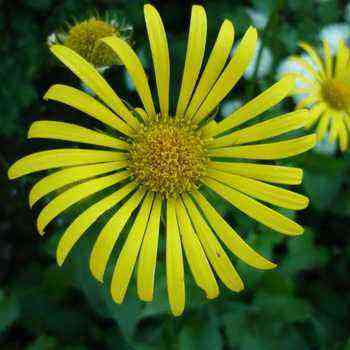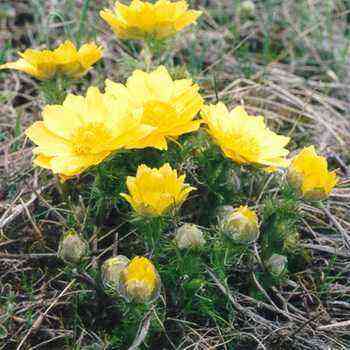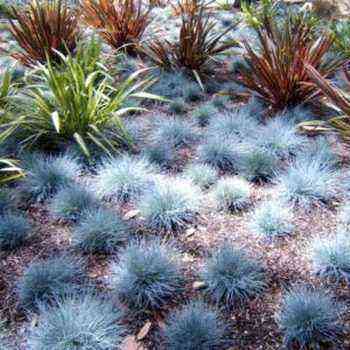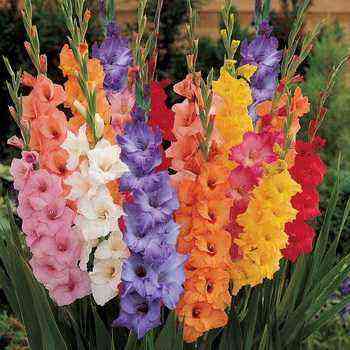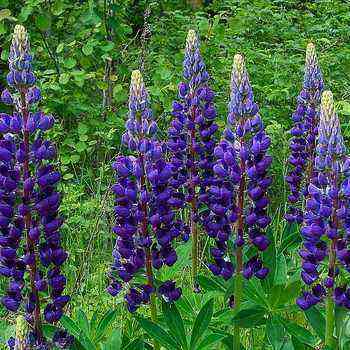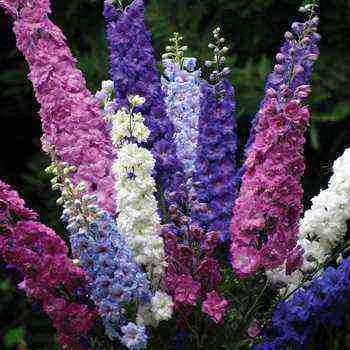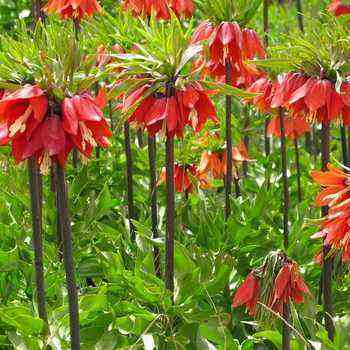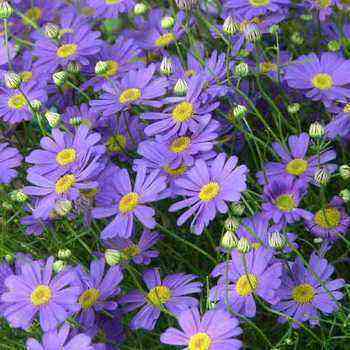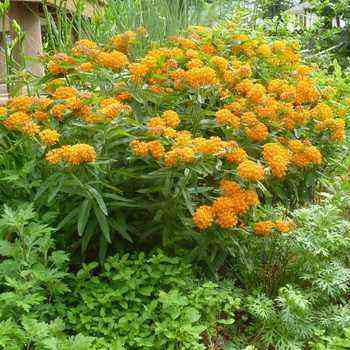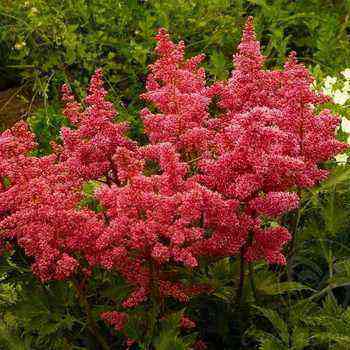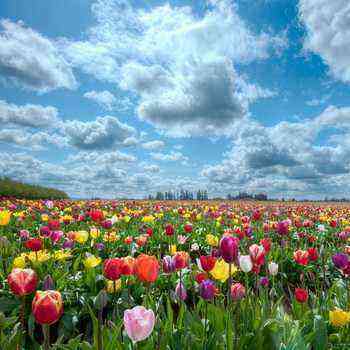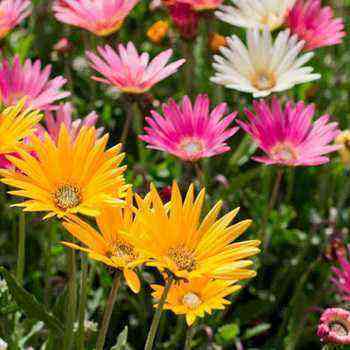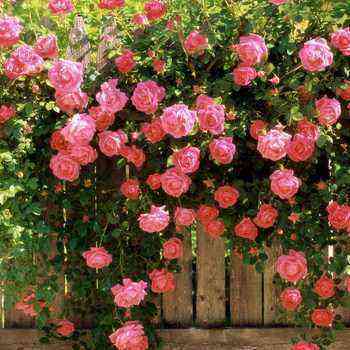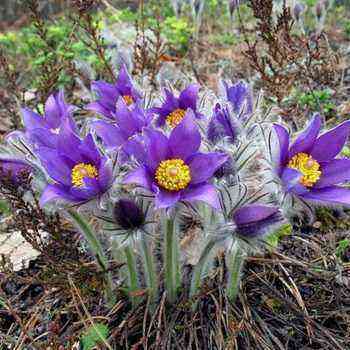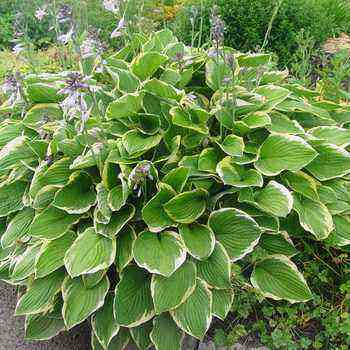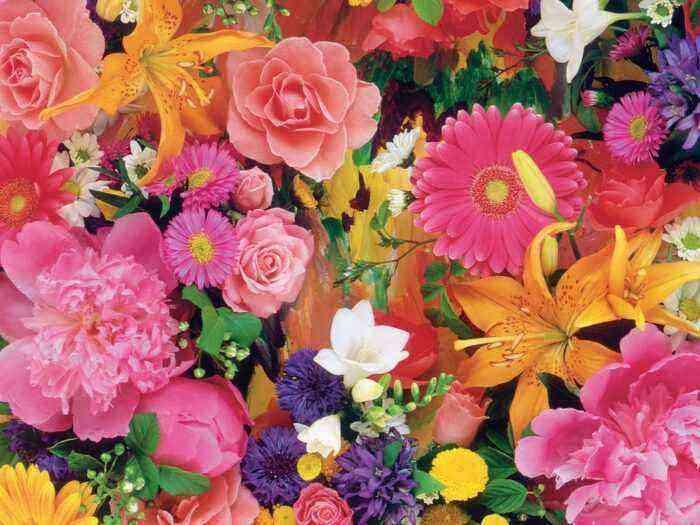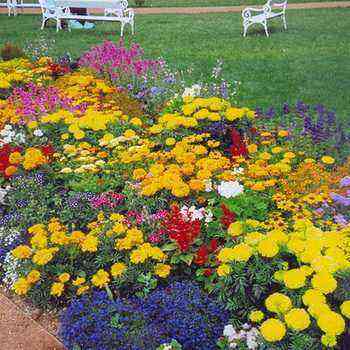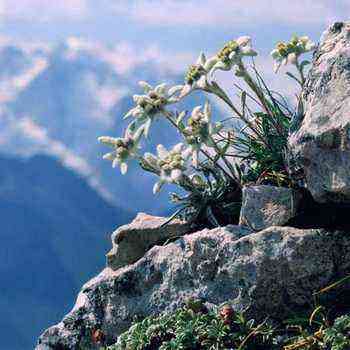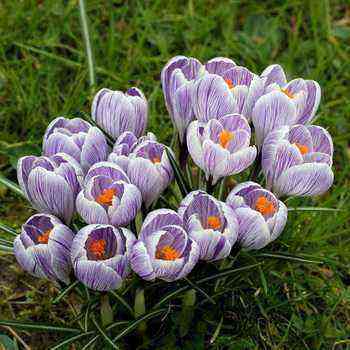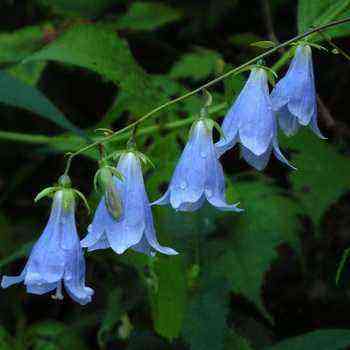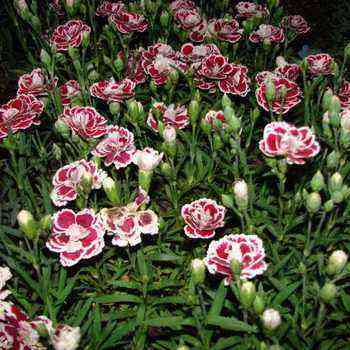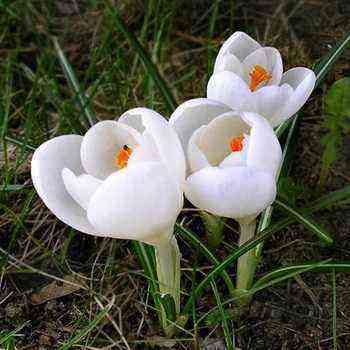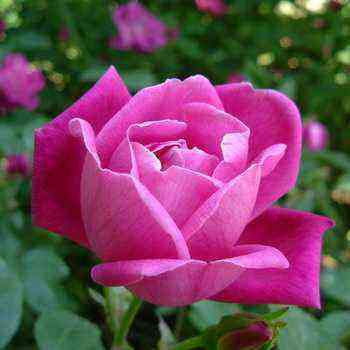 Narcissus is a spring flower, and, unfortunately, you can enjoy its beauty for a very short time (on average, about two weeks). But on the other hand, the bulbs of these plants can remain in the ground for 5-8 years, and without any effort in the spring, your site will again be decorated with small “suns” of daffodils with white or yellow petals and a bright (sometimes even orange) center. And if you have time, you can have time to collect a bouquet of these primroses, and they will stand for a long time in the cut.
Narcissus is a spring flower, and, unfortunately, you can enjoy its beauty for a very short time (on average, about two weeks). But on the other hand, the bulbs of these plants can remain in the ground for 5-8 years, and without any effort in the spring, your site will again be decorated with small “suns” of daffodils with white or yellow petals and a bright (sometimes even orange) center. And if you have time, you can have time to collect a bouquet of these primroses, and they will stand for a long time in the cut.
What daffodils and their bulbs look like (with photo)
Garden flowers daffodils belong to the amaryllis family. There are about 60 known wild species growing on the Mediterranean coast of Europe and North Africa, as well as in England and Ireland. Daffodils grow in deciduous mountain forests and wet meadows, up to the subalpine belt. In the Carpathians, there is a narrow-leaved daffodil, listed in the Red Book as a rare species.
Many legends have been dedicated to the description of a daffodil flower of an elegant shape with a captivating aroma, poets wrote poems about it. The name of the plant is associated with an ancient Greek myth: the beautiful young man Narcissus saw his reflection in the water and could not tear himself away from it. He died on the bank of a stream out of love for himself. And in this place a surprisingly beautiful flower with a bowed head grew, which people called a daffodil.
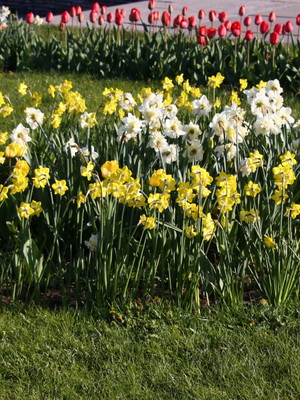
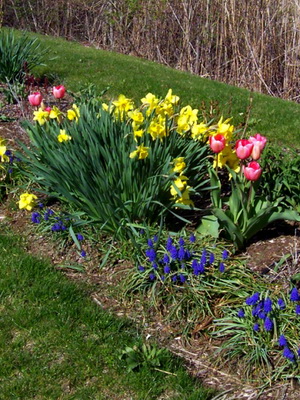
Daffodils look good in flower beds, rabatki, alpine slides, mixborders, lawns and lawns. Ideal for spring bouquets. Almost all varieties can be distilled.
Daffodils belong to the group of ephemeroids, that is, they grow and develop during the short spring period. In the middle lane, daffodils bloom in late April – May, flowering lasts 1-3 weeks. By July, the aboveground part of the plant dies off, and the bulb remains in the soil. In this way, the plant tolerates an unfavorable period of drought and cold weather.
What does a daffodil look like, so beloved by gardeners and widely cultivated in almost all summer cottages?
As you can see in the photo, the flower in daffodils of most species and varieties is single, it can be located vertically, obliquely or hang freely:

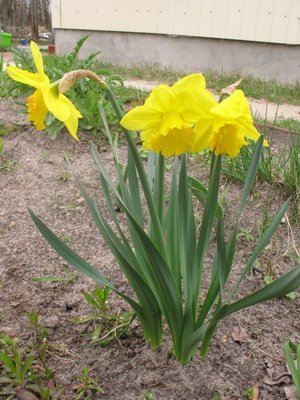
Much less often, at the top of the peduncle, several flowers are collected in an umbrella-shaped inflorescence. The flowers are large to medium in size with a pleasant, sometimes very strong aroma.
The perianth consists of six lobes, petals. The fused outgrowths of the lobes form a crown or tube of different heights, diameters, and shapes. The crown and perianth can be the same color or different. The shape and color of the crown are the main varietal characteristics.
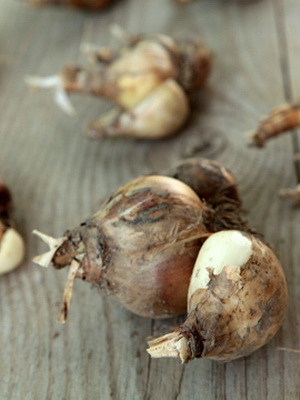

The bulbs of daffodils are perennial. Young, never flowering bulbs are single-peaked, over the years their structure becomes more complicated, they become two – and then three-peaked.
Pay attention to the photo of mature daffodil bulbs – they are large, round or elongated-oval, their shape is often determined by the varietal affiliation:
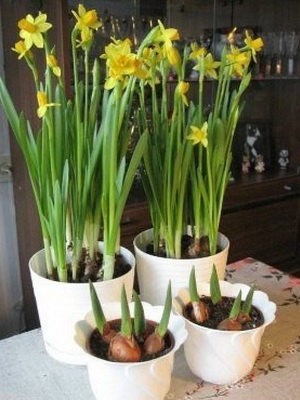
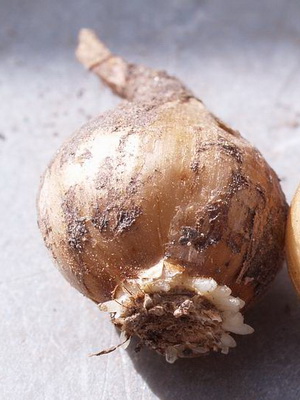
Every year 1-3 babies are laid in the bulb. Renal formation of renewal is completed mainly in 2 years. Narcissus bulbs practically do not have a dormant period, since there is a continuous development of two renewal buds of different ages. This allows the plants to be affected two to three years before flowering.
How to grow and how to care for daffodils
Daffodils are less whimsical culture than hyacinths and tulips. Cultivated soils are best suited. Before growing daffodils, prepare a soil with sufficient humus, good structure and a neutral reaction. For optimal care and cultivation of daffodils, groundwater should lie no higher than 50-60 cm from the surface, otherwise, with heavy rainfall, daffodils will die off the tips of the roots, which will lead to a deterioration in growth. On heavy, moist soils, where excess moisture stagnates in spring and autumn, drainage needs to be arranged. Sandy and heavy clay soils can be improved by adding more humus. Fresh manure is applied a year before planting, and well-rotted manure immediately before it (in this respect, daffodils are not as sensitive as other bulbous ones).
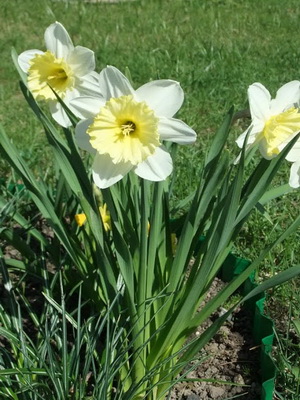

They prefer open, sunny places, but plants can also be planted in partial shade. How to care for daffodils depends on the class of plants: individual groups of these crops have their own characteristics. Cyclamenous are more demanding on moisture. The Zhonkilievs need a lot of sun, they grow better on clay soils. Triandrus trees tolerate shade better and can be grown even on northern slopes. Poetic daffodils don’t like the annual transplant.
For successful planting and caring for daffodils, the soil for sowing is prepared in the spring by adding superphosphate (30 g / m2), as well as peat, humus or compost at the rate of 1.5-2 buckets per 1 m2. The soil is dug up to a depth of 30-35 cm and cultivated several times during the summer.
How to plant daffodils: planting and caring for bulbs outdoors
Daffodil bulbs are planted earlier than hyacinths and tulips – in late August or early September. Their dormant period is short, and you need to have time to plant them before root formation. Poetic ones are planted first, then small and large-crowned, the last tubular. The bulbs, planted at the optimal time, have time to develop a powerful root system before frost, as a result of which they tolerate wintering well.
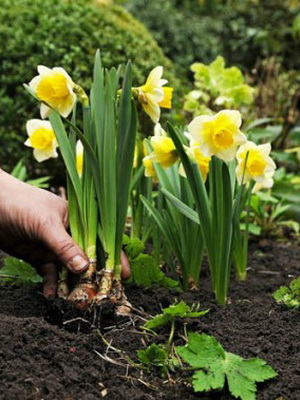
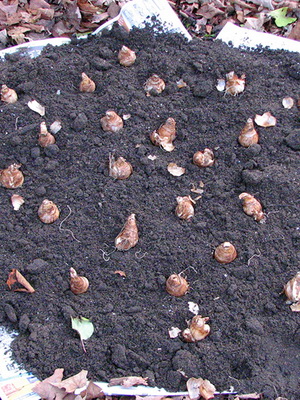
Before planting daffodils, you need to prepare holes with an average depth of 12-15 cm: on heavy soils, no more than 12 cm, on light soils – up to 17 cm. Small bulbs and baby are planted to a depth of 10 cm from the bottom. The bulbs are placed at a distance of 7-10 cm from each other, large – 15 cm. When densely planted daffodil flower bulbs are larger. With a rare planting, more children are formed.
Immediately after planting daffodils in open ground, when caring for them, the bulbs are watered abundantly, the ground is mulched with peat or humus with a layer of 2-3 cm. When the soil is 4-5 cm frozen, daffodils are covered with foliage, straw or chopped reeds. Especially carefully you need to cover the daffodil daffodils, poetic shelters do not require.
In the spring, after the snow melts, the shelter is removed, leaving a layer of mulch, and immediately fertilizing with nitrogen fertilizers is carried out at the rate of 20-30 g of ammonium nitrate per 1 m2. Then, every 10-12 days until the end of flowering, complex fertilizers with microelements are applied.
When caring for daffodil flowers, do not forget that these plants are quite hygrophilous. During the growing season, they are regularly watered, especially in hot, dry weather. A lot of water is required for daffodils after flowering, when the bud of a future flower develops in the bulb. In the middle lane, watering is continued for another 4-6 weeks after flowering. Weekly 2-3 buckets of water are added to 1 m2 of plantings.
Here you can see a photo of caring for daffodils during the growing season and after flowering:
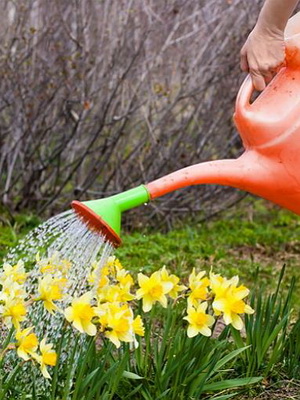
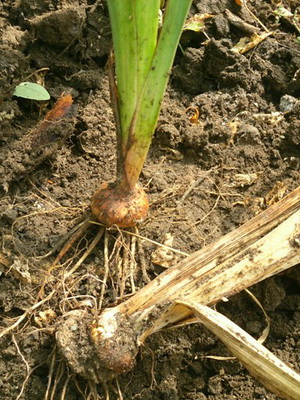
Should you dig up daffodils and how to store the bulbs?
Many summer residents are concerned about the question of whether daffodil bulbs need to be dug up annually or can they be left in the ground? Daffodils can be dug up every year or after 2, 3, 4 years. The bulbs are usually dug up in July, when the leaves have dried up.
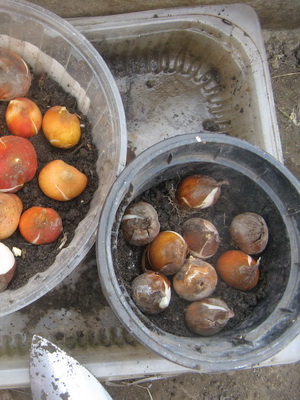

And how to store daffodil bulbs in order to get excellent planting material in the spring? Washed immediately, laid out in one layer in boxes with a mesh bottom. Dry for 2-3 weeks at 20-25 ° C in a ventilated room or under a canopy. Before planting, the bulbs are stored at a temperature of 17-20 ° C and an air humidity of 70-80%.
If the bulbs are not dug up, then after drying, the leaves are removed and the ground is leveled with a rake. In this case, the holes left in the soil after harvesting the leaves will be filled in, which will make it difficult for hoverfly larvae to penetrate the bulbs. In the future, weeds are regularly destroyed. In the second half of August, watering and feeding are resumed.
For more than 5 years without transplanting, you can keep plants on the lawn in free groups resembling natural ones, as well as on an alpine slide. In this case, a very deep planting is used to suppress the vegetative propagation of the bulbs.
To obtain the maximum number of bulbs, an annual transplant is carried out. To this end, immediately after digging, without drying, the bulbs are planted on pre-prepared ridges. The compromise is a two-year crop, which allows you to get a lot of cut and a sufficient yield of bulbs.
Varieties of tubular daffodils with photos and names
Numerous varieties and forms of daffodils are the result of the hard work of many generations of breeders. Work on the creation of new varieties began in the 18th century, and the greatest success has been achieved in our time. Now more than 12 thousand varieties of daffodils are known. In 1950, the Unified International Classification of Narcissists was adopted, which distinguished 12 classes (groups).
Below are descriptions of the daffodil plants of each group and their best varieties.
1. Tubular – the crown is long, in the form of a tube, exceeds the length of the petals or is equal to them, the flowers are single, usually large. The height of the peduncle is 30-50 cm, the bulbs are large, reaching 5 cm in diameter. This group of daffodils is one of the oldest, but until now a fifth of the assortment sold are flowers of this class.
Take a look at a photo of what the most popular varieties of tubular daffodils look like:
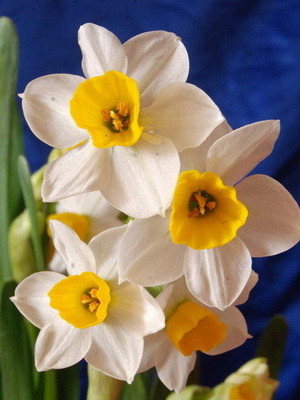
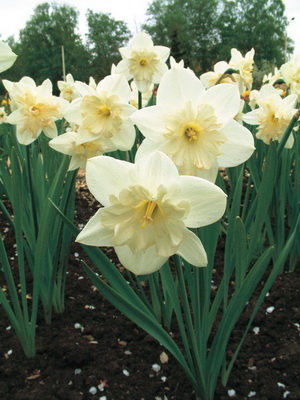
“Victoria”. The flower is located vertically, 9 cm in diameter, the lobes are cream, the tube is yellow, cylindrical, with a bent wavy edge, 3 cm high. It blooms from the beginning of the second decade of May. Suitable for cutting, forcing, gardening.
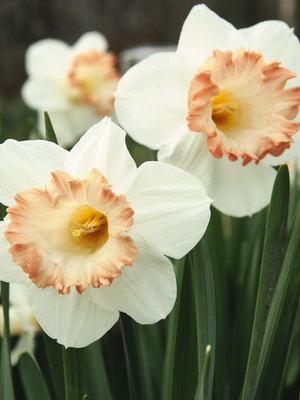

Easter Bonnet. The flower is more than 10 cm in diameter, the perianth is white, the tube is super-corrugated, pink with a border of more intense color.

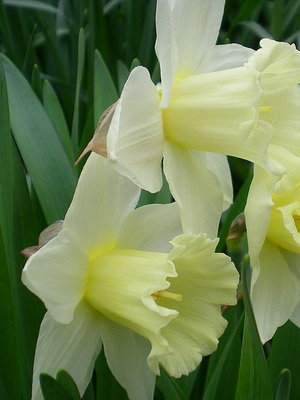
Mount Hood. The perianth lobes and tube are pale cream; over time, the tube changes color to white. The flowers are very large (up to 12 cm in diameter), they remain on the plant from 14 to 19 days, in the cut – 10-12 days. Peduncles up to 40 cm. Plants are resistant to unfavorable weather. The variety has a high multiplication factor.

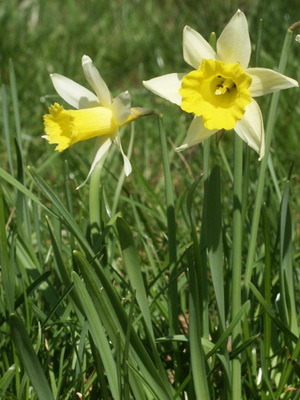
Rembrandt. The flower is large, 10 cm in diameter, of a uniform golden yellow color. The tube is 4 cm high, cylindrical. Peduncle 20 cm, leaves are gray-green, flat. The aroma is weak. Blooms from the second decade of May. Suitable for group planting and forcing.
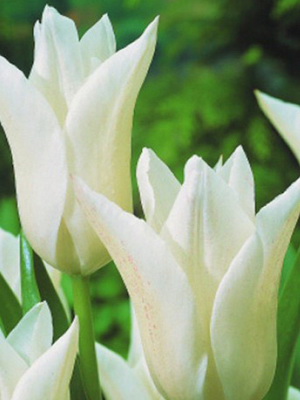
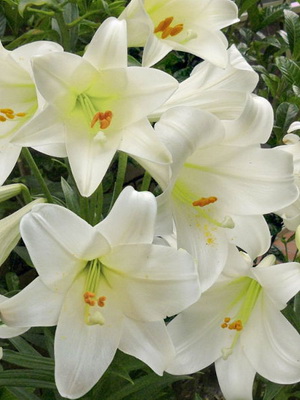
“White Triumphant”. The flower is large (10 cm in diameter), pure white. Perianth lobes are pressed to the tube. The tube is 5 cm high with a fawn tint. The edges of the tube are notched and corrugated. Blooms in May. Suitable for cutting and flower decoration.
Varieties of large-crowned and small-crowned groups of daffodils
Here you can see the photos and names of varieties of daffodils of the large-crowned and small-crowned groups.
2. Large-crowned – tubular or funnel-shaped crown, more than 1/3 of the length of the petals. Daffodils of this class are highly decorative, among them there are varieties with a pink color. Their peduncles are longer than those of tubular ones, which makes them indispensable in bouquets. Currently, varieties of large-crowned daffodils are in the greatest demand.
Popular varieties:
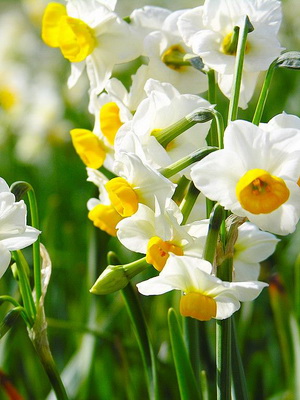
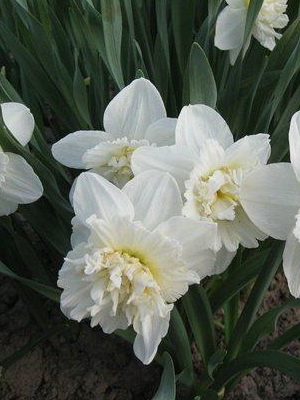
Confuoko. The flower is large, 12 cm in diameter, creamy yellow. The crown is large, yellow, orange at the edges, 4.5 cm in diameter, 2.5 cm high. Plant height is 50 cm. It blooms from the end of April. The use is universal.
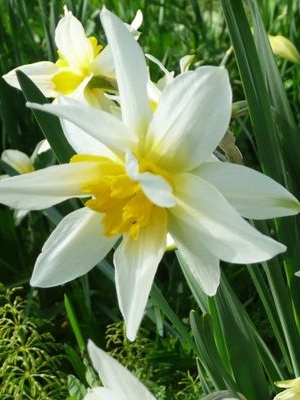

Orange Monarch. The flower is large, 10 cm in diameter, the perianth lobes are white, rounded, the crown is bright orange, wide (4.5 cm), with a wavy edge. Peduncle about 30 cm. The aroma is good. Blooms from mid-May. Suitable for cutting and forcing. A very showy variety.
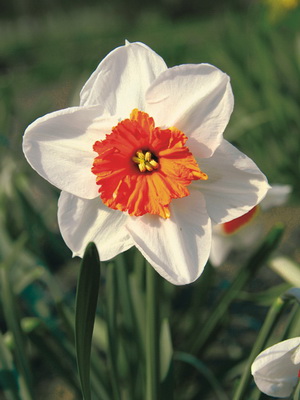

“Professor Einstein”. The flower is large, 9 cm in diameter. The petals are white, rounded. The crown is low, only 0.8 cm high, 4.5 cm in diameter, dark orange, corrugated. The height of the peduncle is 40 cm. It blooms at the end of May. Suitable for cutting and flower decoration.


Champagne. The crown is creamy pink in the form of a wide semi-tube. The stem is strong, high (50-60 cm). Blooms in the third decade of April.
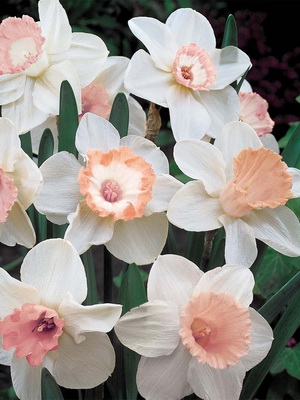
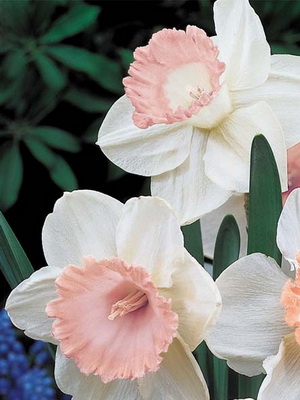
Lady Bird. The crown is pink, conical. Plant height 40-50 cm blooms in late April – early May.
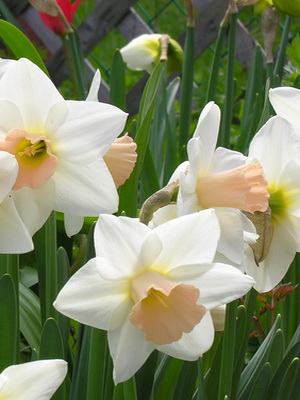
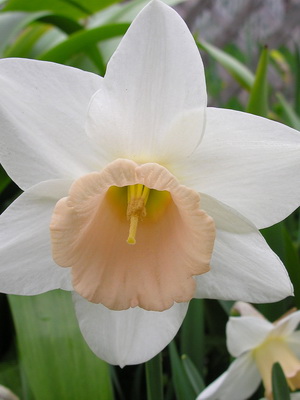
Pink Glory. The crown is pure pink, tubular. Possesses a strong pleasant aroma. Plant height 40-50 cm blooms in late April – early May.
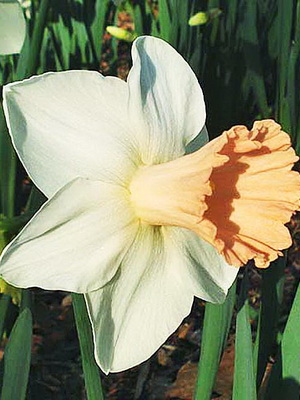
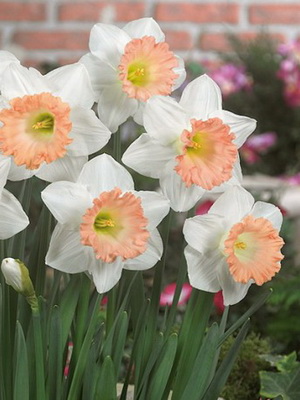
Rosie Sunrise. The crown is creamy pink, funnel-shaped, strongly corrugated along the edge. Plant height 40-50 cm blooms in late April.
3. Small-crowned – crown no more than 1/3 of the length of the petals, often with an orange edging. The petals themselves are often rounded, the flowers are rather large. The peculiar flavor gives this class of daffodils a special charm. Bloom later than the first two groups. They are not widely used.
The following varieties are widely known:
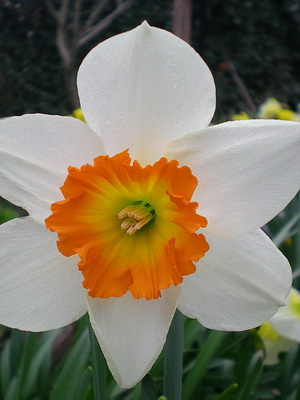
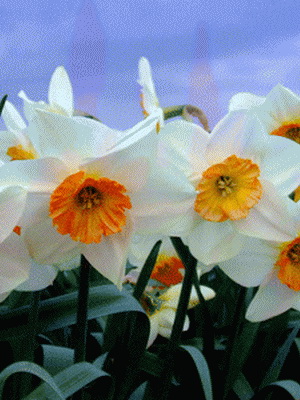
“Amor”. A flower up to 11 cm in diameter has slightly creamy petals that fade over time and turn white. The crown is 2.5 cm high, 5.5 cm in diameter, yellow with an orange border, in the form of a wide bowl with a corrugated edge. Peduncle up to 40 cm high. The average flowering period, flowers last 18-22 days.
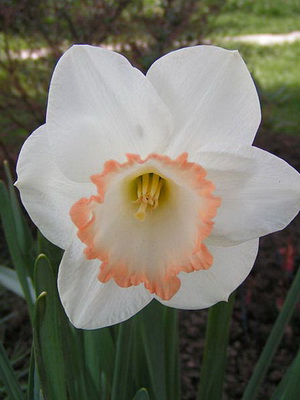

Epicote Distinction. Flower up to 8 cm in diameter. The petals are white, smooth, the crown is orange, apricot to the edge, wavy, 1.5 cm in height and 2.5 cm in width. The aroma is pungent. Blooms in the second half of May. Suitable for cutting and group planting.
The best varieties of the terry group of daffodils
4. Terry – this includes varieties of a very different structure and origin with double flowers, blooming simultaneously with small-crowned ones. Peduncles are low – 25-30 cm, which limits their use in bouquets.
The best varieties of terry daffodils:
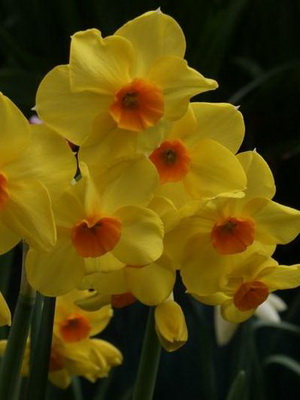
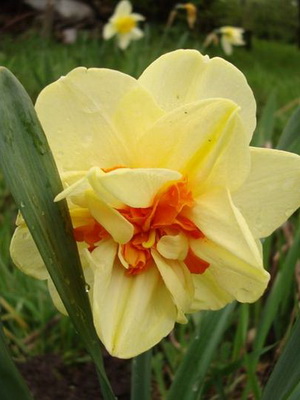
Gay Challenger. A flower up to 10 cm in diameter with a white double perianth and an orange-red double crown. Late. Great in cut.
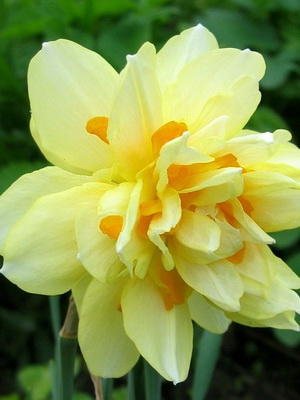

“Texas”. Large double flower, 9 cm in diameter. Greenish-yellow lobes interspersed with narrow orange ones. The aroma is strong. Blooms from mid-May. Suitable for cutting, forcing and group planting.

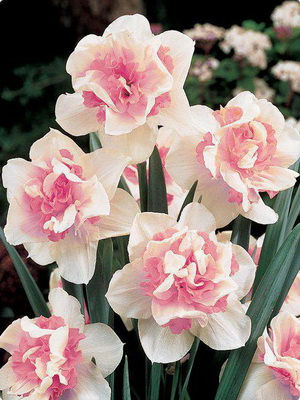
Chirfulness. On the peduncle there are 3-4 flowers up to 4 cm in diameter. The outer lobes are rounded, white, the inner ones are smaller, white, interspersed with creamy yellow outgrowths of the crown. The aroma is good. Peduncle 30-35 cm high. Blossoms from the twenties of May. The variety is suitable for cutting, forcing.

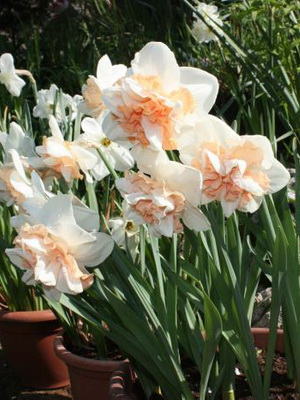
Twink. A flower with delicate apricot-pink petals. The height of the peduncle is 40-45 cm. It blooms in late April.

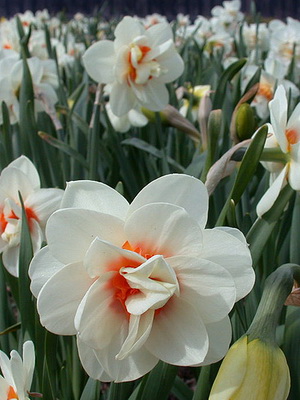
Pink Paradise. Flower (9 cm) with white double perianth, double crown, orange-pink. Late. Suitable for cutting and gardening.
Trindrus daffodil varieties
5. Triandrus – flowers are collected in umbellate inflorescences of 2-4 pieces on one peduncle. Plant height up to 30 cm. Not widely used, however, in amateur gardens, especially terry forms are in demand.
The best varieties of daffodils in this group:
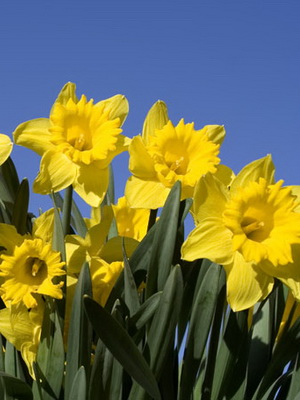
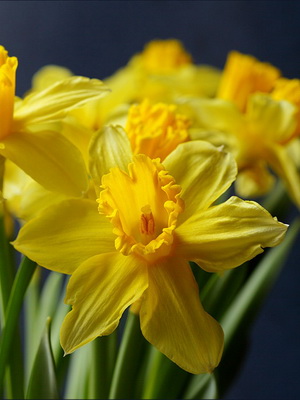
Jet Phase. Flowers with turned-back petals, yellow. The crown is orange-red with a wavy edge, large. Plant height up to 30 cm. It is used for cutting, flower decoration.
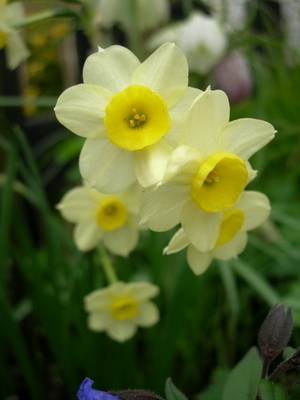

Minow. The flowers are drooping, creamy white, the tube is large, yellow, with a wavy edge. Plant height about 20 cm. It is used for rocky hills.

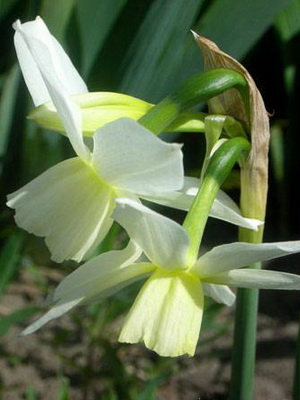
“Waist”. There are two flowers on the peduncle. The petals are narrow, white, slightly bent back. The tube is long white. The aroma is weak. Plant height 20 cm. It is used in group plantings, for forcing in pots.
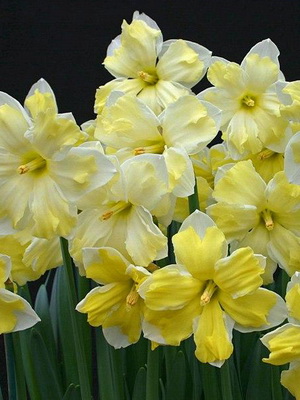

“Title Tettle”. The flowers have light yellow petals and a crown. The plant is strong, with several flowers on the peduncle. Height about 30 cm. It has a pleasant aroma. Suitable for cutting and garden design.
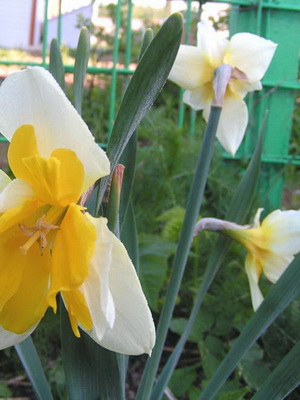

Tresumble White. There are 2 flowers on the peduncle. One is large (up to 8 cm in diameter), the other is smaller. The lobes are white, bent back. The crown is white, cylindrical, with a wavy edge, 2.5 cm high and 3.5 cm wide. The aroma is pleasant. Blooms in the second half of May. The variety is weakly winter-resistant, sometimes the buds freeze slightly. Suitable for cutting and group planting.
Here are photos of varieties of trindrus class daffodils:
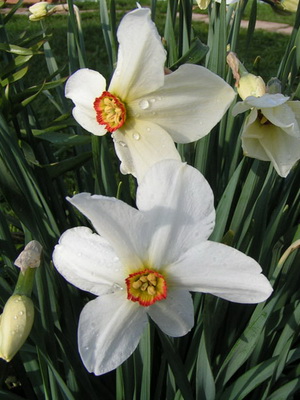
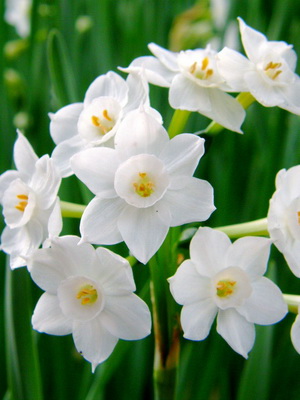
Cyclamen-like, Jonquillian and tacetal groups of daffodils
6. Cyclamen – come from the cyclamen narcissus. Flowers with a long crown and strongly curved petals. This shape makes them look like a cyclamen. The earliest flowering time.
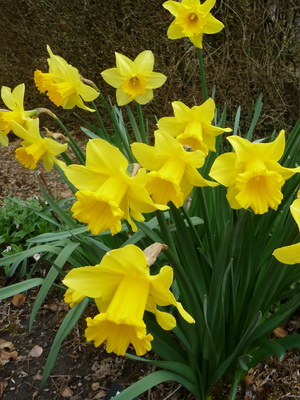
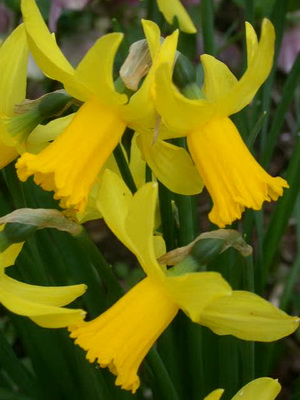
The most famous variety is “Februari Gold”. The flowers are drooping, the petals are bent back, golden yellow, the crown is darker, longer, with a wavy edge. Peduncle height up to 20 cm. It is used in flower decoration and for cutting.
7. Jonquilliae – originate from the narcissist Jonquilla. On the peduncle there are 2-3 very fragrant flowers. The perianth lobes are elongated, the crown is goblet, whole, shorter than the petals.
The following varieties are most popular:
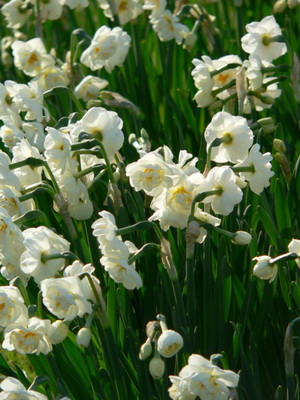
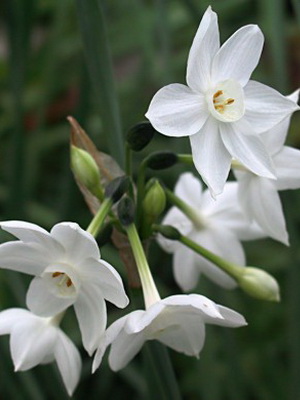
Cherie. The flower (7 cm) is graceful, delicate, fragile with a white perianth and a creamy pink crown. Late. Great in cut.
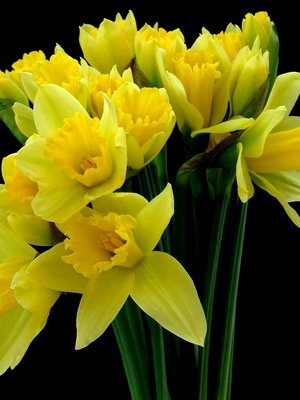

Golden Scepter. On the peduncle there are 2-3 flowers up to 4 cm in diameter. The lobes are horizontally spread, rounded, yellow. The crown is cup-shaped, 1.5-2 cm high, yellow. The aroma is good. Blooms in early May. Suitable for cutting as well as group planting.
8. Tacetnye – the group is obtained from crossing various varieties with the daffodil Taceta (bouquet). The flowers are medium-sized, fragrant, 3-8 on one peduncle, the crown is less than 1/3 of the length of the petals. These daffodils are hardy.
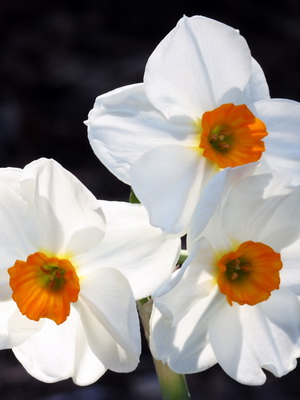
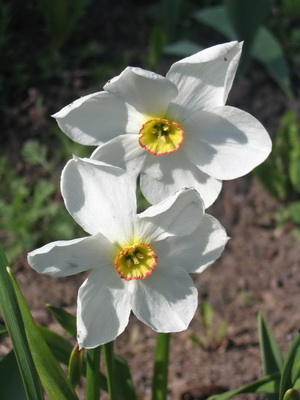
Known variety “Geranium”. The flowers are medium-sized (up to 5 cm in diameter), collected in an inflorescence of 3-5 pieces. The perianth petals are white, the crown is flat, bright orange. Peduncles about 30 cm high. Flowers last 9-20 days on a plant and 10-12 days in cut. The variety is suitable for forcing and gardening.
Poetic and wild-growing daffodil classes
9. Poetic – originate from the poetic narcissist, from whom they inherited white fragrant single flowers. The crown is short, yellow, with a bright orange rim.
The most popular varieties of the group:
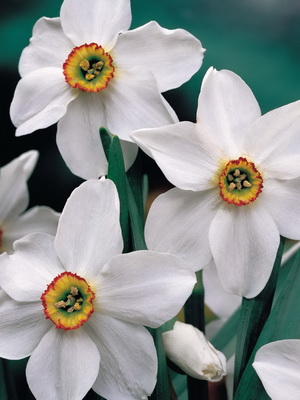
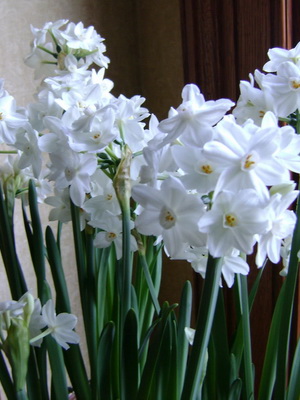
“Akteya”. Fragrant flower up to 9 cm in diameter, white, yellow crown with a red border. Peduncle height up to 50 cm. It blooms from mid-May. Suitable for cutting and group planting.
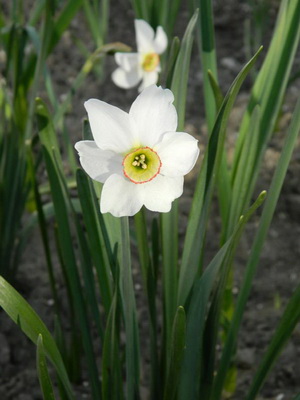

“Horace”. The flower is 8 cm in diameter, the lobes are white, smooth, densely overlapping each other. The crown is corrugated, yellow with a bright orange edge. The aroma is very pleasant. Blooms from the twenties of May. It is used for cutting, forcing and group planting.
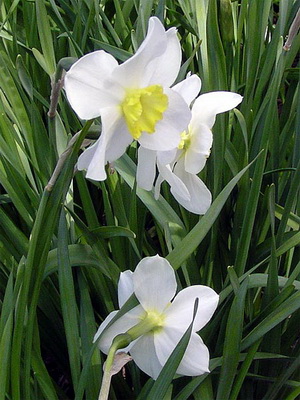

Dante. The flower is 6 cm in diameter. The lobes are white, rounded. The crown is yellow with a yellow-orange jagged edge. The aroma is good. It blooms in the third decade of May. The variety is over a hundred years old, but it still hasn’t lost its significance.

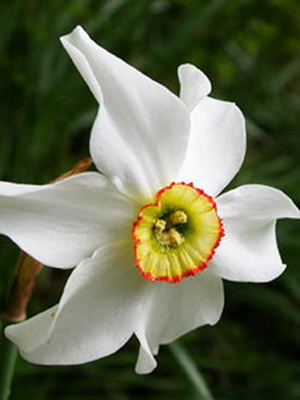
Red Rome. The flower is 5 cm in diameter. The lobes are round, folded, white. Light orange crown with red piping. It blooms on the twentieth of May. Suitable for cutting and group planting.
10. Wild species, their forms and natural hybrids – this group is used for making slides and breeding work.
The most commonly grown varieties are:
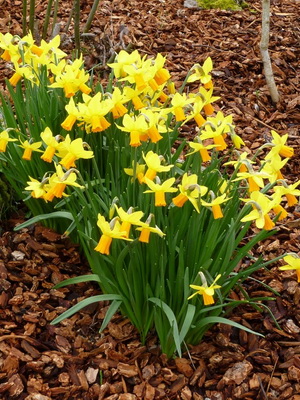
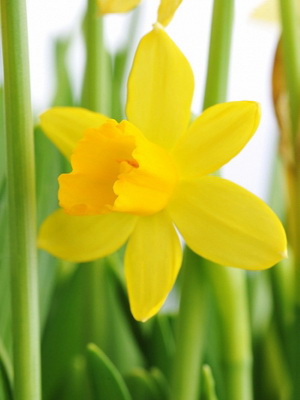
“Obvalaris Salisbari”. The flower is horizontally located with a diameter of about 7 cm. The perianth segments are light yellow, ovoid, smooth. The crown is bright yellow, cylindrical, with a wavy edge 3.5 cm high, 2.5 cm in diameter. It blooms from the beginning of May. The aroma is weak. Suitable for group plantings.


Ornatus Maximus. The flower is vertically arranged with a diameter of 8 cm. The perianth segments are white, smooth, elliptical. The crown is yellow-orange, bowl-shaped, 0.3 cm high, 1.5 cm in diameter. It blooms from the second decade of May. The aroma is strong. Suitable for group plantings.
The best varieties of the split-crown group of daffodils
11. Split-crown – have an original, split into several parts (usually 6) crown. The height of the peduncles, depending on the variety, ranges from 25 to 50 cm, the diameter of the flower is 7-11 cm, the diameter of the crown is 2.5-10 cm. Currently, this group of daffodils occupies a special place due to the variety of flower shapes.
According to the shape of the crown, 3 subgroups are distinguished:
1) the crown fits snugly to the petals;
2) does not adjoin the petals along the entire length, the lobes are curved, notched along the edge;
3) resembles a six-rayed star with narrow lobes.
Grades:
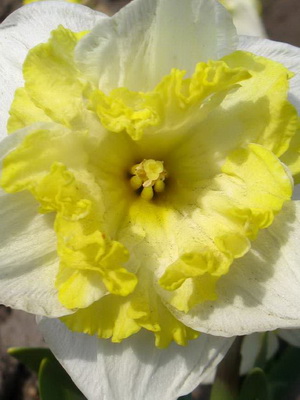
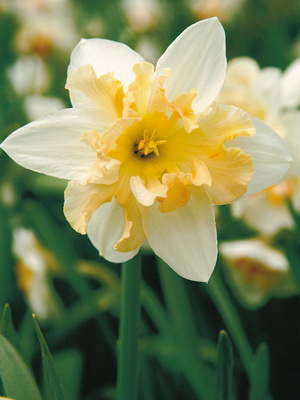
“Printl”. The flower is 11.5 cm in diameter, the perianth is white, the crown is yellow with an unusually beautiful “curly” (fringed) edge. The flower is shaped like an orchid.
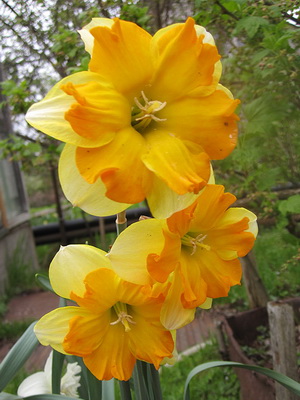
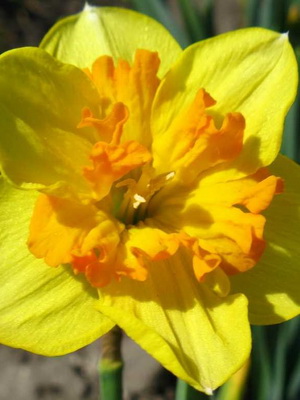
Mondragon. A flower 10.5 cm in diameter with a bright yellow perianth, a dark orange crown, corrugated. Medium, versatile.
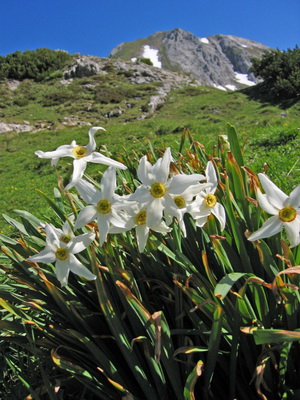
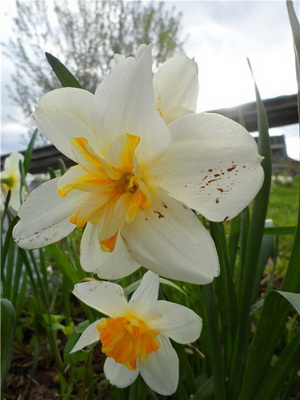
“Riesling”. The flower is 9.5 cm in diameter, light lemon yellow, the crown is split almost to the base with a corrugated edge. Medium late. It is mainly used for cutting.

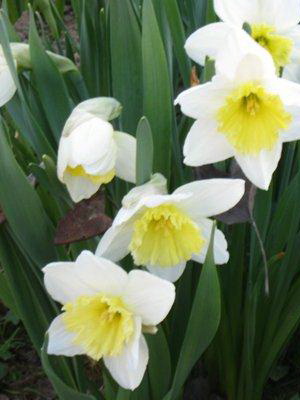
Royal Hayness. A flower 10 cm in diameter with a white perianth, a yellow-orange crown, curly, corrugated, with a wavy edge. Medium, versatile.
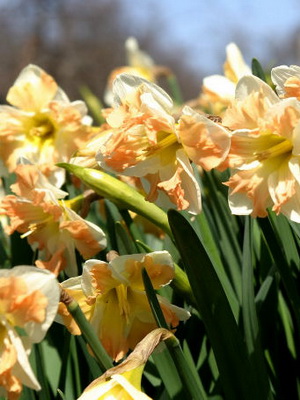
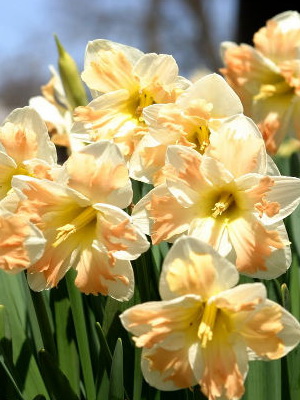
“Sanker”. Flower 11.5 cm in diameter with a creamy white perianth, azalea crown, light cream with a wavy edge, 9 cm in diameter. Medium, universal.
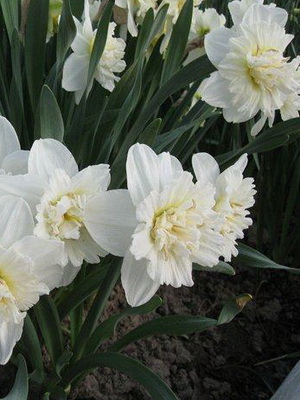
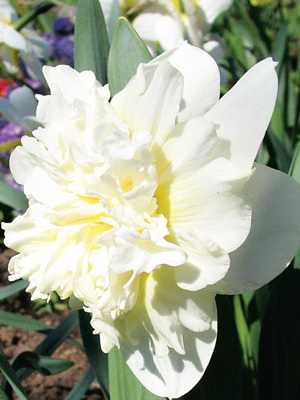
Silver Shell. A flower 10-11 cm in diameter with a white perianth, a large crown (8.5 cm), soft cream, corrugated. Early, versatile.


Sovrin. The flower is 8-9 cm in diameter with a white perianth, the crown is bright orange, corrugated. Medium, versatile.
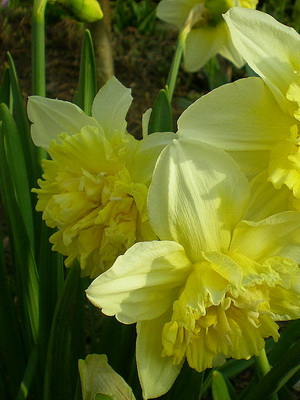
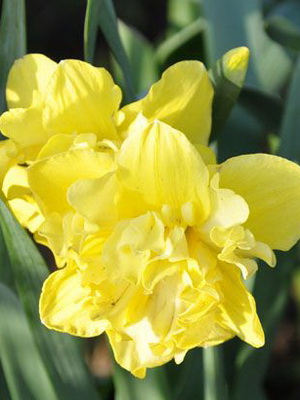
Flyer. A very spectacular one-color bright yellow flower (11-12 cm), curly crown, corrugated with outgrowths. Medium late, versatile.
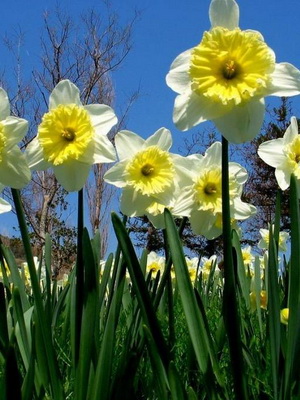

“Egard”. A flower 10.5 cm in diameter with a white perianth and a lemon-yellow crown. Late, versatile.
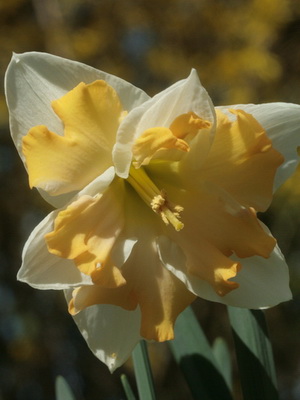
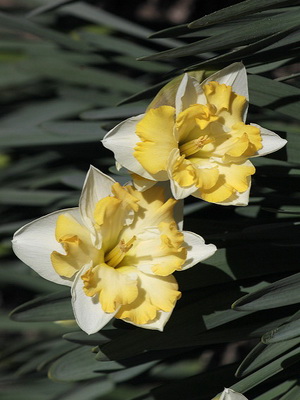
Etincelant. Flower with a diameter of 10 cm with a white perianth, azalea crown, creamy pink. Medium late, versatile.
12. This group includes all other daffodils not included in the previous groups.


